Pasaules Militārā Enciklopēdija
> ASV
> Lentes
> Armijas plecu ielāpi
> Signāla korpuss
> US-PTSUS-00023

261 Signal Brigade Patch. US Army
Gadījuma:
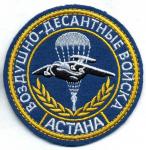
Patch Airborne Forces of the Republic of Kazakhstan
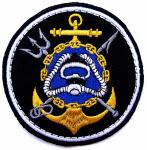
шеврон специального подразделения боевых пловцов ЧФ ВМФ России

нашивка специального подразделения боевых пловцов ВМС Украины.
Mainīt informāciju
Description
A lozenge with horizontal axis 3 3/8 inches (8.57 cm) overall and vertical axis 2 3/4 inches (6.99 cm) overall consisting of four lozenges conjoined, the upper of colonial blue and bearing a white five pointed star and each of the remaining three divided into white and orange areas by a zig-zag partition line, all within a 1/8 inch (.32 cm) buff border.
Symbolism
Orange and white are the colors used by Signal units. Colonial blue and buff were suggested by the flag of the state of Delaware. The single star alludes to Delaware as the "first state" to sign the Constitution; it is also used to indicate the capital city of Dover, the unit's home area. The pattern formed by the conjoined lozenges is indicative of precise planning and represents the unit's capabilities. The white and orange zig-zag simulates electric flashes and refers to the technology of a communications system and the unit's mission.
Background
The shoulder sleeve insignia was originally approved for 261st Signal Command on 7 January 1971. It was amended to correct the description on 27 January 1971. The insignia was redesignated for the 261st U.S. Army Strategic Communications Command on 19 January 1972. It was redesignated for the 261st Signal Command on 4 December 1974. It was redesignated for the 261st Signal Brigade effective 1 September 1996. (TIOH Dwg. No. A-1-542)
A lozenge with horizontal axis 3 3/8 inches (8.57 cm) overall and vertical axis 2 3/4 inches (6.99 cm) overall consisting of four lozenges conjoined, the upper of colonial blue and bearing a white five pointed star and each of the remaining three divided into white and orange areas by a zig-zag partition line, all within a 1/8 inch (.32 cm) buff border.
Symbolism
Orange and white are the colors used by Signal units. Colonial blue and buff were suggested by the flag of the state of Delaware. The single star alludes to Delaware as the "first state" to sign the Constitution; it is also used to indicate the capital city of Dover, the unit's home area. The pattern formed by the conjoined lozenges is indicative of precise planning and represents the unit's capabilities. The white and orange zig-zag simulates electric flashes and refers to the technology of a communications system and the unit's mission.
Background
The shoulder sleeve insignia was originally approved for 261st Signal Command on 7 January 1971. It was amended to correct the description on 27 January 1971. The insignia was redesignated for the 261st U.S. Army Strategic Communications Command on 19 January 1972. It was redesignated for the 261st Signal Command on 4 December 1974. It was redesignated for the 261st Signal Brigade effective 1 September 1996. (TIOH Dwg. No. A-1-542)
Citas kategorijas: Signāla korpuss
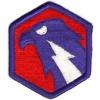 6 Signal Command Patch.US Army
6 Signal Command Patch.US Army
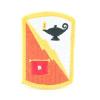 15 Signal Brigade Patch. US Army
15 Signal Brigade Patch. US Army
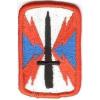 1101 Signal Brigade Patch. US Army
1101 Signal Brigade Patch. US Army
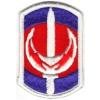 228 Signal Brigade Patch. US Army
228 Signal Brigade Patch. US Army
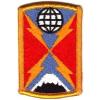 1104 Signal Brigade Patch. US Army
1104 Signal Brigade Patch. US Army


